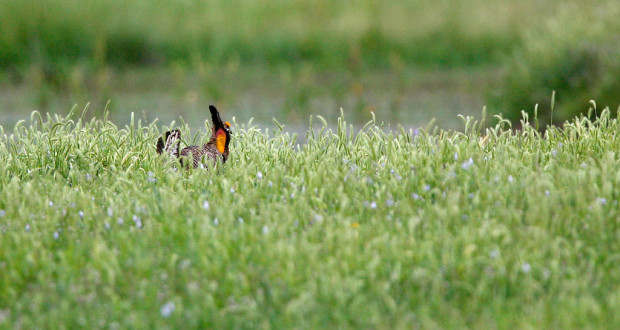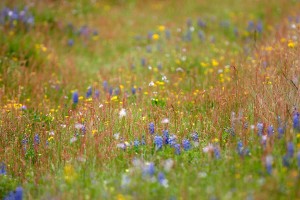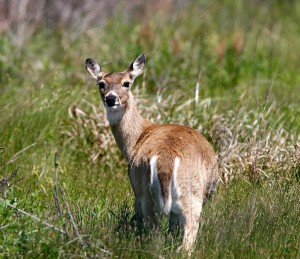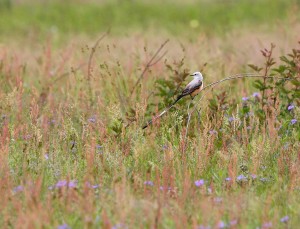As with many endangered species, its decline closely tracks the erosion of its native habitat, in this case the grassy prairies along the Gulf Coast, which steadily gave way to growing cities, thriving industry and expanding farms. The Attwater Prairie Chicken National Wildlife Refuge is one of the largest remaining coastal prairie habitats in Texas.
Don’t count on seeing the birds, but if you do, the males put on quite a display in the morning and evening from February through early May. With their tails up and their wings down they inflate bright orange sacs under their throat and stomp about vigorously in an effort to attract a mate. During the breeding season, the refuge offers tours every Saturday.
But the refuge is about more than just the prairie chicken, supporting more than 250 species of birds and other wildlife. The U.S. Fish and Wildlife Service describes the diversity of the refuge’s inhabitants:
White-tailed hawks soar over the prairies. Crested caracaras and vultures keep a sharp lookout for carrion. These scavengers are like the janitors of the grasslands, cleaning up after other wildlife. During the summer months, scissor-tailed flycatchers and dickcissels grace the grasslands. In the refuge impoundments, roseate spoonbills carry the pink glow of a morning sunrise on their wings. You might see anhingas perched on branches with their wings spread wide to dry. In winter, geese abound in neighboring fields, while the refuge hosts a diversity of ducks, sandhill cranes, Sprague’s pipit, and one of the most diverse lists of sparrow species in the region…. Night time prowlers include bobcats, coyotes, and the nine-banded armadillos. During the day, you’ll have a good chance of seeing bison…. American alligators share the ponds with smooth and spiny softshell turtles. Bullfrogs and upland chorus frogs fill the night air with their calls.
A five-mile auto trail and three hiking trails wind through the refuge. In the spring, they are ablaze with wildflowers – bluebonnets, golden groundsel, wine cups and Indian paintbrushes.
The auto trail loops around the center of the refuge, following Couchatta Creek, then heading out across the prairie. On the far side, it slips through patchy wetlands before returning through the brushy grassland that dominates the refuge.
Look for Little Blue and Green Herons along the creek; sparrows, flycatchers and Dickcissels clinging to the prairie grasses; Bobwhite Quail scurrying by the roadside; and wetland birds such as Yellow-crowned Night Heron and Killdeer stepping through the marsh. On the back of the auto trail as it turns toward the visitors center, look for hawks and Crested Caracara perched in the brush or sweeping gracefully over the prairie. White-tailed deer often graze near the road in the morning, while Jackrabbits dart across the road.
The refuge’s three short trails all come off the main road.
An unnamed trail crosses a large footbridge over Couchatta Creek and climbs up a hill to a small pond and wetland. There’s a wildlife blind on the edge of the pond and a grassy path that wanders a short way in both directions.
The Pipit Trail (2 miles) cuts through the tall prairie grass and is paved with wildflowers in the spring. The trail turns a corner at a marshy pond about a third of the way in and rounds another pond closer to the end. There’s not a bit of shade, though, and parts of the trail get fairly muddy after a rain. But on a spring or fall morning it’s a great place to wander through uninterrupted prairie. The trailhead is right at the corner where the entrance road turns toward the visitor’s center.
The Sycamore Trail (1.5 miles) crosses a more diverse landscape of rolling prairie and woodlands, dipping down to the banks of Couchatta Creek near the San Bernard River. The trailhead is at the wooden gate just adjacent to the visitor’s center.
(The refuge brochures say the Sycamore Trail is the longer of the two, but the Pipit Trail definitely seemed the longer on a recent walk of both).
REFUGE GALLERY
















You must be logged in to post a comment.